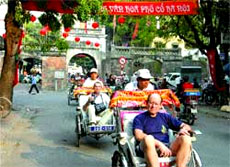In honour of the 1,000th anniversary of Ha Noi, the capital has put together a tour that allows travellers to learn more about the city's unique history. The tour was launched by the Ha Noi Department of Culture, Sports and Tourism in order to celebrate the city's 1,000th anniversary.

The first leg of the tour brings guests to the Thang Long Royal Citadel. From the 11th to 18th century, the capital city was built around the citadel. There were also numerous lakes and rivers that served as transportation routes throughout the city. The citadel had three different sections that seperated its grounds.
The Co Loa-Ha Noi Ancient Citadel Preservation Centre recently sent an application to UNESCO requesting to have Thang Long Citadel recognised as a world heritage site, said Tran Quang Dung, Deputy Director of the centre.
After the citadel, the tour moves on to a historic house at 87 Ma May Street. The delightful house is one of the rare historic structures that has been preserved in Ha Noi.
The house was built at the end of the 19th century. The ground floor was used to sell goods, and the interior of the home was used as a living space. The house is open Monday to Friday, from 9am to 11.30am, and from 2 to 5pm.
Ha Noi's Old Quarter was orginially established as a craft district in the 11th century after King Ly Thai To built his palace in the area.
In the early 13th century, the group of tiny workshop villages that were clustered around the palace walls eventually evolved into craft co-operatives. Skilled craftsmen then began to migrate to the quarter, and artisan guilds were formed by craftsmen who had come from rural villages.
Members of the guilds worked and lived together. The artisans created a co-operative operating system that organised the guilds' transportation networks which shipped the area's goods all over the city.
Because the inhabitants of each street came from the same village, streets developed a homogeneous appearance.
The government at the time taxed the shopkeepers based on the width of their home, which resulted in owners increasing the length and depth of their homes to reduce street from area. Although the old section of Ha Noi is often referred to as the "36 Old Streets", there are actually more than 36 streets in the district.
Some researchers believe that the number 36 originated in the 15th century when there might have been 36 guilds, which were workshop areas and not streets. When the streets were built, the streets then took on the name of the guild that existed in the area. All of the street names started with "Hang", meaning commodity, which was followed by the craft that was sold in the area.
For example, Hang Gai Street primarily sells silk clothing, embroidery and silver products. Hang Quat formerly sold silk and feather fans, but now sells brilliantly coloured boxes, flags and religious paraphernalia. To Tich Street primarily sells timber. Now, it is commonly refered to as the ‘street of fruit juice' by Hanoians.
Today, Ha Noi's Old Quarter is defined as the 74 streets covering 100ha that boast 112 cultural and historic sites in Hoan Kiem District.
O Quan Chuong is also an attraction for tourists and foreign researchers who are

interested in the capital's history. O Quan Chuong's official name is written in ancient Han Chinese characters, and is still visible on top of the main gate below the bell tower.
After you move under the gate, the street becomes Hang Chieu, which passes in front of the chaotic Dong Xuan Market. The street then turns into Hang Ma Street, which might just be the most atmospheric part of the capital's Old Quarter.
All Hanoians possess memories about the countless shopping trips they have taken to the Old Quarter since childhood.
The gate once served as the eastern entrance to the capital's citadel. The other four entrances, along with the old perimeter wall, were destroyed during the city's rapid urban development period.
Viet Nam has recently launched the country's National Tourism Year (NTY) 2010. Ha Noi Department of Culture, Sports and Tourism’s Deputy Director Mai Tien Dung said the department created a programme with travel agencies. The package is entitled Itinerary Through Ancient Viet Capitals.
"Travellers will have a chance to visit many of Viet Nam's ancient capitals including Hung Temple, Co Loa Temple, Hoa Lu and Thang Long Citadel," said Dung.
The department has released 2,000 DVDs in English and Vietnamese, with an aim to popularise these tour packages.
The DVD introduces viewers to the cultural and historical values of Hanoians. The film also describes traditional-folk games and crafts that are popular throughout Viet Nam.
Tasty foods such as steamed rolls made of rice-flour,
pho (rice noodle soup),
bun oc (noodles and snails) and lotus tea are also introduced in the film.
Ha Noi also signed agreements with Bangkok (Thailand), Vientiane (Laos), Fukuoka (Japan), Singapore and the Chinese provinces of Guangxi, Yunnan and Hainan to promote and popularise Viet Nam's NTY 2010, Dung said.
Viet Nam's tourism sector hopes to welcome 4.6 million foreign travellers and host 27-28 million domestic tourists this year. The sector also hopes to gross VND75,000-78,000 billion ($3.9-4.1 billion).